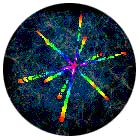|
|
 |
 |
 |
 |
|
 |
|
|
|
|
|
|
|
CosmoSCIET
Astrophysics from a SCIET perspective
CosmoSCIET looks at astrophysics, the study of the formation and composition of stars and their companion bodies, for insights on SCIET Theory. This includes the formation of molecules in the heat and gravity of stars and their subsequent distribution.
To most people, including astronomers, galaxies are large, groupings of hundreds of billions of stars, streaming with immense clouds of gas and dust, covering areas hundreds of thousands of light-years in diameter. In cosmology, however, a galaxy is just a unit of matter. The observable universe contains billions of them in clusters three million or more light-years across. These clusters then congregate into still larger groupings. At all levels observed by astronomers, galaxies appear to cluster and form complex structures.
 The illustration above overlays a SCIET on a map of the universe. SCIET suggests that the visible Universe sits in the middle of much larger Void space and represents the separation and consolidation of charge from that area. The illustration above overlays a SCIET on a map of the universe. SCIET suggests that the visible Universe sits in the middle of much larger Void space and represents the separation and consolidation of charge from that area.
|
|
The study of these very large phenomena is thought to be the best source of basic insights regarding nature, since the physical processes that were dominant during the early growth of the universe and later through gravitational interactions must represent the underlying principles of creation.
The immense size of the Universe makes the evolution of life seem incredibly small, but SCIET Theory adds another dimension to this issue because it postulates that the Universe has an unseen component that permeates space with resonance and may be the best explanation for ``dark matter". It accounts for the attractive force and represents an inward traveling reaction to the creation that is equally ancient. In this scheme each proton has a portion of the original void in its center that is continuing to collapse inward at a rateproportional to the apparent expansion of the universe.
We can call it a collapse, but it is really an inward expansion that is responsible for numerous natural constants, including the speed of light, C. Though vast, the finite size of our Universe is reflected in the system of finite relationships observable in the size and speed of creation.
In order to visualize the Universe as a creation derived from SCIET Theory it is necessary to say that the Universe has orientation, and recent anistrophic observation experiments suggest that this is true. These experiments have shown that there is a difference in how light behaves when traveling in different directions or in different areas. This has been established by anistrophic measurements.
This finding is an important confirmation of SCIET Theory.
|
|
|
|
Please contact our Webmaster with questions or comments
Copyright 1995-2013© Dane Michael Arr |
|
|
|
|





 The illustration above overlays a SCIET on a map of the universe. SCIET suggests that the visible Universe sits in the middle of much larger Void space and represents the separation and consolidation of charge from that area.
The illustration above overlays a SCIET on a map of the universe. SCIET suggests that the visible Universe sits in the middle of much larger Void space and represents the separation and consolidation of charge from that area.